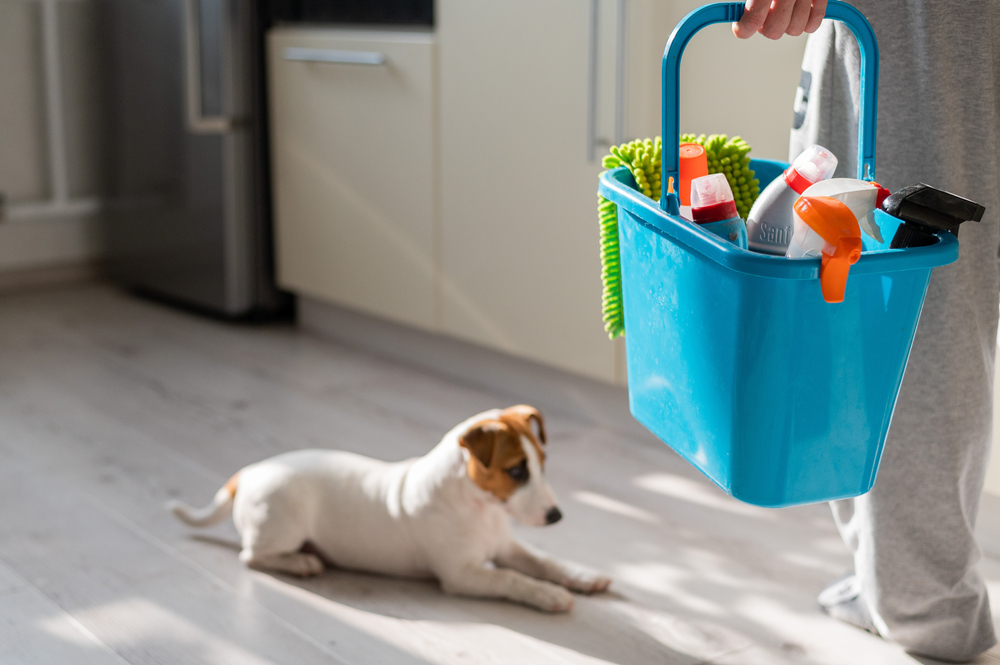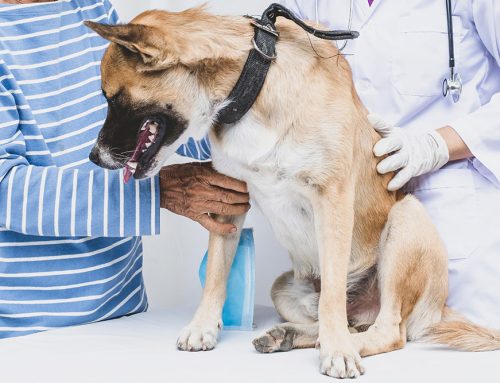Our homes are sanctuaries filled with love, comfort—and pets. But hidden throughout our home, often hidden in plain sight, lie many everyday items that harbor toxins that seriously threaten our beloved pets. At Adamson Veterinary Services, we’re passionate about empowering pet owners with the knowledge to shield their animals from these unseen risks, so we offer an explanation of these potential threats and simple precautions you can take to create a safe and secure haven for your cherished companion. Pet Poison Prevention Week is March 17 to 23, so this is the perfect time to brush up on your pet poison knowledge.
In your home: Human items toxic to pets
We all love to treat our pets, but human foods, such as table scraps, can be dangerous. Seemingly harmless snacks, like raisins, can cause long-term, sometimes fatal damage to dogs and cats. Here are more foods that can harm your pet:
- Chocolate — These tempting tidbits are toxic trouble for pets. Only small amounts of chocolate can cause tremors, vomiting, and seizures. Grapes, raisins, onions, and garlic are also dangerous for pets. Remember, “safe for humans” doesn’t translate to pets.
- Xylitol — Artificial sweeteners can be sneaky about endangering your pet. Xylitol, which is used in many popular products, including sugar-free gum and candy, can lead to a rapid drop in blood sugar and liver failure in pets. Keep these items out of reach and securely stored and ensure your children know not to feed your pet any candy.
- Medications — Over-the-counter pain relievers like ibuprofen and acetaminophen may be your friend, but they are your pet’s foe. Keep all medications, including vitamins and supplements, out of reach. Don’t assume something natural is safe, because most remedies for humans, including homeopathic treatments, can harm pets.
In your home: Chemicals dangerous for pets
Everyone likes to keep a clean home, but don’t clean at your pet’s expense.
- Cleaning items — Bleach, ammonia, drain cleaners, and other cleaning products boast harsh chemicals that help keep your house clean, but can irritate your pet’s skin and eyes and cause internal damage if ingested. Store these products securely, use them only as directed in well-ventilated areas, and consider pet-safe alternatives whenever possible.
- Pest preventives: — Mouse poison, mole bait, flea preventives, and insecticides meant for unwanted critters can be fatal to curious pets. Rat poison in particular is dangerous to pets, who are attracted to the sweet taste. Opt for pet-safe pest control methods whenever possible, store rodenticides and insecticides securely, and dispose of used products properly. Also, remember that pets can be poisoned not only when they ingest the liquid, but also if they eat a poisoned animal.
- Essential oils — These products are definitely not essential for pets. Diffused essential oils may be popular for their natural properties, but can be toxic to animals when inhaled or ingested. Diffuse oils only in well-ventilated areas out of reach and far away from pets.
In your home: Plants toxic to pets
Research a plant or flower for its potential toxicity before using them to decorate your home. Many plants (e.g., spider plants, African violets) are pet-safe options.
- Houseplants — While greenery brightens our homes, some popular plants, including aloe vera, philodendron, snake plants, and English ivy, are harmful to cats and dogs.
- Flowers — Tulips, daffodils, and even seemingly innocent-looking dieffenbachia and azaleas pack a punch, causing mouth irritation and digestive upset. Lilies are particularly dangerous for cats, who can suffer kidney failure and potentially death if they eat the smallest amount of the flower or the vase water.
In your home: Miscellaneous objects dangerous for pets
Pets can be like children and put everything in their mouth. Many household items you likely do not think of as dangerous can harm your pet, including these examples:
- Batteries — Button batteries and those found in electronics pose a serious internal threat if swallowed. Secure battery compartments tightly and keep loose batteries out of your pet’s sight and out of reach.
- String-along items — Linear objects like string, yarn, and fishing line can become lodged in a pet’s digestive system, requiring surgical removal. Supervise playtime with stringy toys, and securely store crafts, sewing, and knitting supplies.
- Small, but big, hazards — Coins, buttons, and small toys present choking hazards, especially for young pets. Watch for dropped loose change and small items such as buttons. Regularly inspect toys for damage and discard those that have been destroyed. Watch for loose squeakers in particular.
Creating a pet-safe home

You can pet-proof your paradise by getting down to your pet’s level and assessing your home for potential hazards.
- Security — Ensure anything and everything, such as electrical cords, cleaning and pest prevention products, and plants and flowers, that could endanger your pet are stored out of reach and out of sight, if possible.
- Safe alternatives — Provide your pet with safe chew toys and treats to redirect their attention away from tempting yet dangerous objects.
- Knowledge — Familiarize yourself with poisoning signs in pets, including:
- Vomiting
- Diarrhea
- Lethargy
- Difficulty breathing.
Always keep the number of our hospital and the ASPCA’s poison hotline available, because your pet will need prompt veterinary attention should they ingest any of these toxic items.
Keeping your pet safe starts with you, but you can protect them by being knowledgeable about hidden dangers in your home and by taking simple precautions. However, the best protection for your pet is regular wellness screenings at our hospital, so we can monitor their health, catch problems early, and help ensure they live a long, healthy life. Contact Adamson Veterinary Services today to schedule an appointment.







Leave A Comment